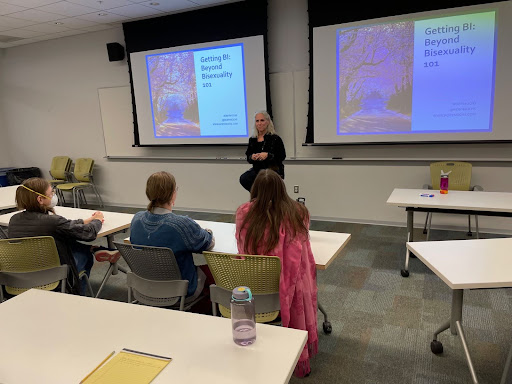Thursday, Nov. 2, the College of William and Mary’s Gender, Sexuality and Women’s Studies Department and Lambda Alliance co-hosted bisexual activist Robyn Ochs for an interactive lecture. Ochs, who uses she/they pronouns, spoke about what it means to identify as bisexual and how to challenge misconceptions tied to the identity.
For the past four decades, Ochs has made a name for herself as a public speaker and grassroots activist for bisexual awareness and advocacy. She has served as editor of the third-oldest bisexual publication in the world, “Bi Women Quarterly”, for 15 years, and has co-edited two bisexual anthologies.
“I’ve spoken out at over 500 colleges and universities in 49 U.S. states,” Ochs said. “And you know, if I have to work until I’m 100, I’m not retiring until I get to speak in Alaska. I’ve also spoken in 19 other countries. So that’s my perspective.”
Within the College, Ochs has garnered a mini fan base of her own. The Lambda Alliance, a queer organization on campus, has been a longtime subscriber to “Bi Women Quarterly” before deciding to reach out. The Alliance’s president, Kell Hoofnagle ’24, described the process of asking Ochs to pay a visit to the College.
“I reached out to Robyn Oaks myself,” Hoofnagle said. “We have an email account, right, and it gets her newsletter and I thought she sounds like a really cool person. And I was like, ‘Well, how much does having her on campus cost?’”
Outside of Lambda, others in attendance were interested in Ochs’ expansion on their gender studies classes. Charlotte Spicer ’27 and Maya Roy ’27 attended the event together.
“We both have Principles of Sociology together and our professor talked about this event and I thought it was interesting. Also, because we’re friends, I figured I’d tag along and learn some new things,” Spicer said.
Ochs began her talk with a clarification of its title, “Getting Bi: Bisexuality 101 and Beyond.”
“This program is called ‘Getting Bi,’ but it’s actually not just about people who identify with that one word,” Ochs said. “This program is really about a range of identity spaces, about people who identify between, or also, beyond the gay-straight binary, and there are a lot of different words that encompass that space.”
Ochs advocated for using the term “bi+”, rather than “bi,” as an umbrella term to encompass the various other identity titles that fall under the label.
Furthermore, 25 years ago, Ochs devised the most well-known and inclusive definition of “bisexual” within the LGBT+ community, taking account of a few revisions over time.
“I call myself bisexual because I acknowledge that I have in myself the potential to be attracted — romantically and/or sexually — to people of more than one gender and/or sex, not necessarily at the same time, not necessarily in the same way, and not necessarily to the same degree,” Ochs said.
“I call myself bisexual because I acknowledge that I have in myself the potential to be attracted — romantically and/or sexually — to people of more than one gender and/or sex, not necessarily at the same time, not necessarily in the same way, and not necessarily to the same degree,” Ochs said.
Ochs then presented data displaying a rise of U.S. residents who identify as bi+, especially among Generation Z, the generation of people born in between the mid-1990s and 2012. She accredited this change to a greater representation in media, a broader knowledge of different sexual identities and access to the internet.
However, Ochs stated that increasing societal acceptance of bisexual identities has not dissolved all of the issues faced by this community.
“Minority stress is the experience of being part of a group that is discriminated against or that has social stigma,” Ochs said. “I want to make it really clear that minority stress is actually not caused by who you are. It’s caused by where you are. It’s an environmental issue.”
For her, legal scholar Dr. Kimberlé Crenshaw’s 1989 concept of intersectionality is very important when thinking about links between identity and oppression. According to Crenshaw, an individual’s identity is shaped by interconnected factors like race, religion and sexual orientation that can also collectively contribute to the layers of societal oppression they may face.
“Her thing was that intersectionality is really focused on systems of oppression, people who are affected by multiple systems of oppression,” Ochs said. “But underneath that, I believe, is the understanding that everyone of us has multiple identities. I am not just my sexual orientation, I am not just my gender. I also have lots of other identities.”
Ochs’ point of intersectionality was to stress that there is no one universal bisexual experience.
Ochs strives to provide more relatable experiences for bi-curious individuals with her various anthologies: “RE*COG*NIZE: The Voices of Bisexual Men- An Anthology and Getting Bi: Voices of Bisexuals Around the World, Second Edition.”
This past September, Ochs celebrated her 47th anniversary of identifying as bisexual and has not looked back.
“For some of us, identifying as bi is an act of integrity. It’s a way of claiming our whole selves,” Ochs said.
“For some of us, identifying as bi is an act of integrity. It’s a way of claiming our whole selves,” Ochs said.
Following the talk, items from Ochs’ Etsy shop, “Bi-Products,” were for sale and profits went towards the nonprofit organization “Bi Women Quarterly”.
Members of the Lamba Alliance and other attendees appreciated Ochs’ confidence in her bi+ identity.
“I really enjoyed it, I really enjoyed it,” Hoofnagle said. “I’ve always been bi, I’ve known that for a while, but I feel currently quite proud of it.”

